Source Rock Assessment of the Permian to Jurassic Strata in the Northern Highlands, Northwestern Jordan: Insights from Organic Geochemistry and 1D Basin Modeling
Abstract
:1. Introduction
- Detecting the source potential by means of determining organic matter quantity and generating potential;
- Identifying the kerogen types and hence predicting types of hydrocarbon products;
- Suggesting the paleo-depositional environment and redox conditions;
- Bracketing the thermal maturity level;
- Predicting the time at which hydrocarbons were generated from the deeply buried source rocks and assessing the likelihood of hydrocarbon generation.
2. Geologic Setting
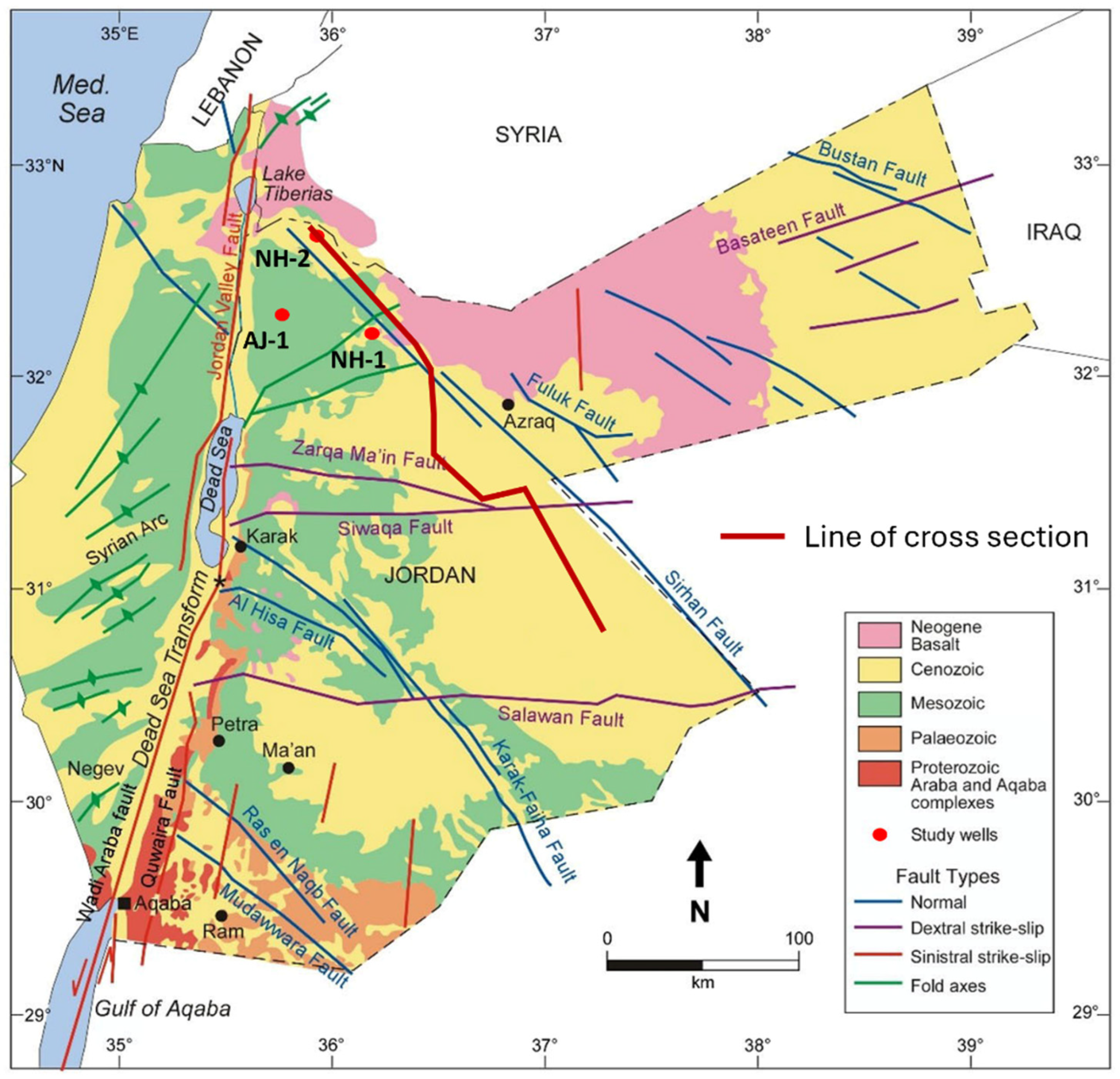
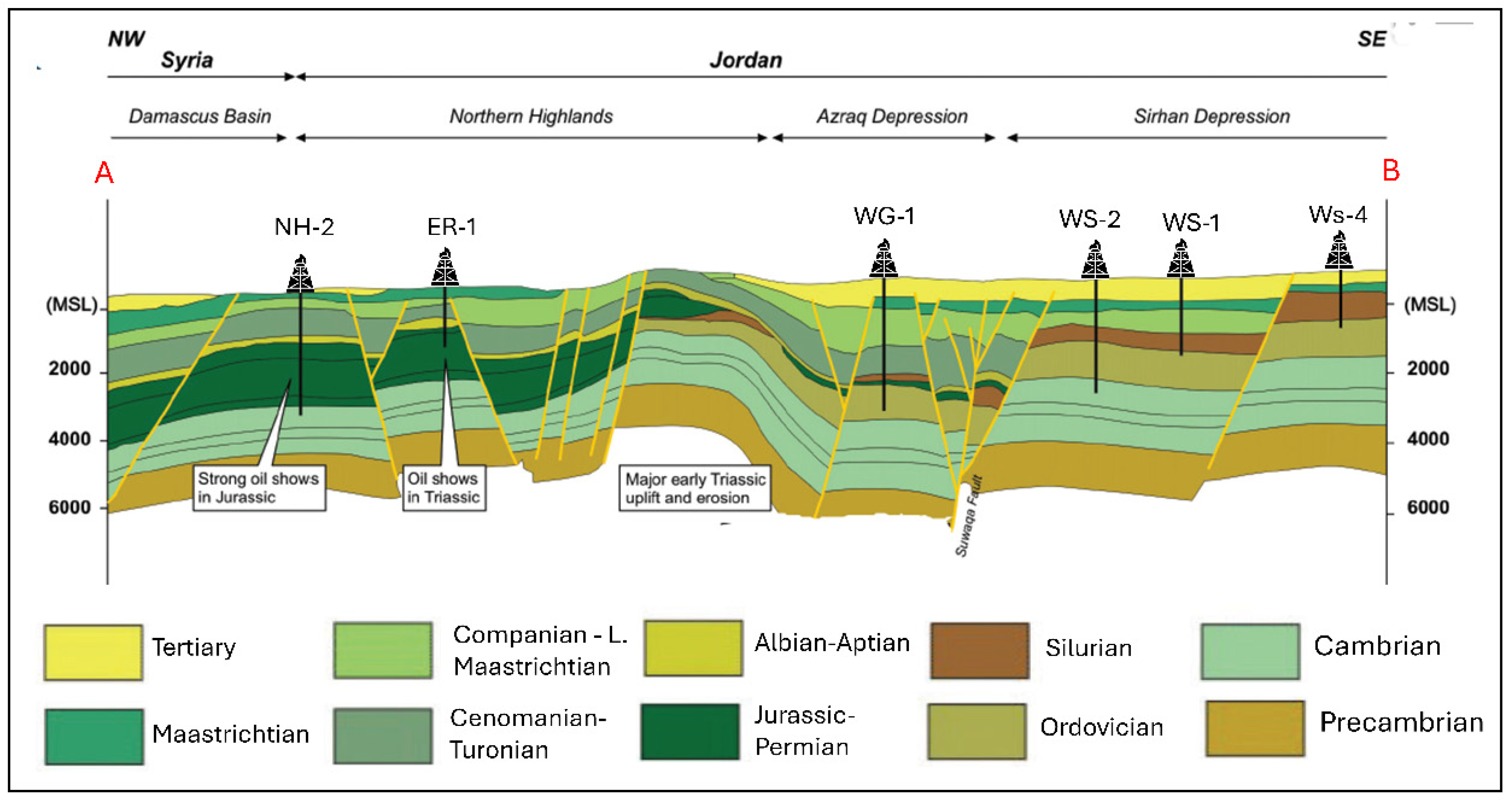
3. Materials and Methods
3.1. TOC and Rock-Eval Pyrolysis
3.2. Visual Kerogen and Vitrinite Reflectance Assessment
3.3. Gross Composition, Gas Chromatography (GC), and Gas Chromatography–Mass Spectrometry (GC-MS)
3.4. Basin Modeling Technique
4. Results
4.1. TOC and Rock-Eval Pyrolysis
4.2. Maceral Types
4.3. Gross Chemical Composition
4.4. Molecular and Biomarkers Characteristics
4.5. Basinal Thermal Evolution History
5. Discussion
5.1. Source Rock Characteristics and Hydrocarbon Potential
5.2. Organic Matter Type
5.3. Organic Matter Origin and Depositional Setting
5.4. Implications for Thermal Maturity and Hydrocarbon Generation
5.5. Exploration Challenges in NW Jordan (Upper Triassic Source Rock) in Comparison to Other Northern Levant Areas
6. Conclusions
Author Contributions
Funding
Data Availability Statement
Acknowledgments
Conflicts of Interest
References
- Beydoun, Z.R.; Futyan, A.R.I.; Jawzi, A.H. Jordan Revisited: Hydrocarbons Habitat and Potential. J. Pet. Geol. 1994, 17, 177–194. [Google Scholar] [CrossRef]
- Naylor, D.; Al-Rawi, M.; Clayton, G.; Fitzpatrick, M.J.; Green, P.F. Hydrocarbon Potential in Jordan. J. Pet. Geol. 2013, 36, 205–236. [Google Scholar] [CrossRef]
- Lüning, S.; Kuss, J. Petroleum Geology of Jordan. In Petroleum Systems of the Tethyan Region; American Association of Petroleum Geologists: Tulsa, OK, USA, 2014; pp. 217–239. [Google Scholar]
- Amireh, B.S.; Schneider, W.; Abed, A.M. Diagenesis and Burial History of the Cambrian-Cretaceous Sandstone Series in Jordan. Neues Jahrb. Fur Geol. Und Palaontol.-Abh. 1994, 192, 151–182. [Google Scholar] [CrossRef]
- Qteishat, A.; AL-Mahasneh, M.A. Hydrocarbons Potential in the Azraq Area. Open J. Geol. 2018, 8, 753–763. [Google Scholar] [CrossRef]
- Farouk, S.; Lofty, N.M.; Qteishat, A.; Ahmad, F.; Shehata, A.M.; Al-Kahtany, K.; Hsu, C.S. Source and Thermal Maturity Assessment of the Paleozoic-Mesozoic Organic Matter in the Risha Gas Field, Jordan. Fuel 2023, 335, 126998. [Google Scholar] [CrossRef]
- Farouk, S.; Qteishat, A.; Sen, S.; Ahmad, F.; El-Kahtany, K.; Collier, R.; Sarhan, M.A. Characterization of the Gas-Bearing Tight Paleozoic Sandstone Reservoirs of the Risha Field, Jordan: Inferences on Reservoir Quality and Productivity. Arab. J. Sci. Eng. 2024, 1–21. [Google Scholar] [CrossRef]
- Shinaq, R. Subsurface Triassic Sediments in Jordan: Stratigraphic and Depositional Characteristics, and Hydrocarbon Potential. J. Pet. Geol. 1996, 19, 57–76. [Google Scholar] [CrossRef]
- Zhang, F.; Shen, S.; Cui, Y.; Lenton, T.M.; Dahl, T.W.; Zhang, H.; Zheng, Q.; Wang, W.; Krainer, K.; Anbar, A.D. Two Distinct Episodes of Marine Anoxia during the Permian-Triassic Crisis Evidenced by Uranium Isotopes in Marine Dolostones. Geochim. Cosmochim. Acta 2020, 287, 165–179. [Google Scholar] [CrossRef]
- Zhao, W.; Luo, P.; Chen, G.; Cao, H.; Zhang, B. Origin and Reservoir Rock Characteristics of Dolostones in the Early Triassic Feixianguan Formation, Ne Sichuan Basin, China: Significance for Future Gas Exploration. J. Pet. Geol. 2005, 28, 83–100. [Google Scholar] [CrossRef]
- Sadooni, F.N.; Dalqamouni, A. Geology and Petroleum Prospects of Upper Triassic Sediments, Jordan. Mar. Pet. Geol. 1998, 15, 783–801. [Google Scholar] [CrossRef]
- Powell, J.H.; Mohamed, B.K. Structure and Sedimentation of Permo-Triassic and Triassic Rocks Exposed in Small-Scale Horsts and Grabens of Pre-Cretaceous Age: Dead Sea Margin, Jordan. J. Afr. Earth Sci. (Middle East) 1993, 17, 131–143. [Google Scholar] [CrossRef]
- Al Hseinat, M.; AlZidaneen, M.; Jaradat, R.; Al-Rawabdeh, A.; Hübscher, C. Tectono-Stratigraphic Framework and Evolution of the Northwestern Arabian Plate, Central Jordan. Tectonophysics 2023, 863, 229993. [Google Scholar] [CrossRef]
- Beydoun, Z.R. Petroleum Habitat, Northern Middle East: A Review. Houst. Geol. Soc. Bull. 1988, 30, 11. [Google Scholar]
- Sadooni, F.N.; Alsharhan, A.S. Stratigraphy, Lithofacies Distribution, and Petroleum Potential of the Triassic Strata of the Northern Arabian Plate. AAPG Bull. 2004, 88, 515–538. [Google Scholar] [CrossRef]
- Al-Rawi, M.M. Petroleum Systems in Jordan. GeoExpro 2014, 11. [Google Scholar]
- Bandel, K.; Salameh, E. Geologic Development of Jordan-Evolution of Its Rocks and Life; Elias Mechael Salameh: Amman, Jordan, 2013. [Google Scholar]
- Powell, J.H.; Abed, A.; Jarrar, G.H. Ediacaran Arabia Complex of Jordan. GeoArabia-Middle East Pet. Geosci. 2015, 20, 99–156. [Google Scholar]
- Abed, A.M. The Geology of Jordan and Its Environment and Water; Publication of the Jordanian Geologists Association: Amman, Jordan, 2000. (In Arabic) [Google Scholar]
- Sharland, P.R.; Casey, D.M.; Davies, R.B.; Simmons, M.D.; Sutcliffe, O.E. Arabian Plate Sequence Stratigraphy–Revisions to SP2. GeoArabia 2004, 9, 199–214. [Google Scholar] [CrossRef]
- Ruban, D.A.; Al-Husseini, M.I.; Iwasaki, Y. Review of Middle East Paleozoic Plate Tectonics. GeoArabia 2007, 12, 35–56. [Google Scholar] [CrossRef]
- Powell, J.H.; Stephenson, M.H.; Nicora, A.; Rettori, R.; Borlenghi, L.; Perri, M.C. The Permian-Triassic Boundary, Dead Sea, Jordan: Transitional Alluvial to Marine Depositional Sequences and Biostratigraphy. Riv. Ital. Paleontol. Stratigr. 2016, 122, 23–39. [Google Scholar]
- Stampfli, G.M.; Hochard, C. Plate Tectonics of the Alpine Realm. Geol. Soc. Lond. Spec. Publ. 2009, 327, 89–111. [Google Scholar] [CrossRef]
- Hardy, C.; Homberg, C.; Eyal, Y.; Barrier, É.; Müller, C. Tectonic Evolution of the Southern Levant Margin since Mesozoic. Tectonophysics 2010, 494, 211–225. [Google Scholar] [CrossRef]
- Frizon De Lamotte, D.; Fourdan, B.; Leleu, S.; Leparmentier, F.; De Clarens, P. Style of Rifting and the Stages of Pangea Breakup. Tectonics 2015, 34, 1009–1029. [Google Scholar] [CrossRef]
- Tarawneh, A.; Atallah, M. Structural Setting of the Jordan Northern Highlands: An Integrated Study Using Surface and Sub-Surface Geological Data by Utilizing GIS Technology. Ph.D. Thesis, University of Cape Town, Cape Town, South Africa, 2011. [Google Scholar]
- Andrews, I.J. Cretaceous and Paleogene Lithostratigraphy in the Subsurface of Jordan; Ministry of Energy and Mineral Resources: Amman, Jordan, 1992. [Google Scholar]
- Haq, B.U.; Hardenbol, J.; Vail, P.R.; Stover, L.E.; Colin, J.P.; Ioannides, N.S.; Wright, R.C.; Baum, G.R.; Gombos, A.M.; Pflum, C.E. Mesozoic and Cenozoic Chronostratigraphy and Cycles of Sea-Level Change. In Sea Level Changes: An Integrated Approach; SEPM Special Publication: Houston, TX, USA, 1988; pp. 71–108. [Google Scholar]
- Makhlouf, I.M.; El-Haddad, A.A. Depositional Environments and Facies of the Late Triassic Abu Ruweis Formation, Jordan. J. Asian Earth Sci. 2006, 28, 372–384. [Google Scholar] [CrossRef]
- Peters, K.E. Guidelines for Evaluating Petroleum Source Rock Using Programmed Pyrolysis. AAPG Bull. 1986, 70, 318–329. [Google Scholar]
- Peters, K.E.; Cassa, M.R. Applied Source Rock Geochemistry: Chapter 5: Part II. Essential Elements. In The Petroleum System—From Source to Trap; American Association of Petroleum Geologists: Tulsa, OK, USA, 1994; pp. 93–120. [Google Scholar]
- ISO 7404-5; Methods for the Petrographic Analysis of Coals—Part 5: Method of Determining Microscopically the Reflectance of Vitrinite. International Organization for Standardization: Geneva, Switzerland, 2009.
- ASTM D7708-14; Standard Test Method for Microscopical Determination of the Reflectance of Vitrinite Dispersed in Sedimentary Rocks. ASTM International: West Conshohocken, PA, USA, 2014.
- Sweeney, J.J.; Burnham, A.K. Evaluation of a Simple Model of Vitrinite Reflectance Based on Chemical Kinetics. AAPG Bull. 1990, 74, 1559–1570. [Google Scholar]
- Pepper, A.S.; Corvi, P.J. Simple Kinetic Models of Petroleum Formation. Part III: Modelling an Open System. Mar. Pet. Geol. 1995, 12, 417–452. [Google Scholar] [CrossRef]
- El Atfy, H.; Ghassal, B.I.; Littke, R. Petroleum Source Rocks of Egypt: An Integrated Spatio-Temporal Palynological and Organic Geochemical Studies Within the Phanerozoic. In The Phanerozoic Geology and Natural Resources of Egypt; Hamimi, Z., Khozyem, H., Adatte, T., Nader, F.H., Oboh-Ikuenobe, F., Zobaa, M.K., El Atfy, H., Eds.; Advances in Science, Technology & Innovation; Springer International Publishing: Cham, Switzerland, 2023; pp. 649–674. ISBN 978-3-030-95636-3. [Google Scholar]
- Chen, J.-Q.; Jiang, F.-J.; Pang, X.-Q.; Yang, H.-J.; Shi, K.-Y.; Pang, B.; Pang, H.; Chen, J.-F.; Chen, Z.-H.; Zhang, X.-G. Characteristics and Origin of Low-Organic-Matter Carbonate Source Rocks in the Middle–Upper Ordovician, Tarim Basin, Northwestern China. J. Palaeogeogr. 2024, 13, 594–619. [Google Scholar] [CrossRef]
- Manga, W.G.O.; Hatcherian, J.J.; Hackley, P.C.; Bessong, M.; Bapowa, C.L.; Pougue, H.E.; Meying, A. Novel Insights about Petroleum Systems from Source and Reservoir Rock Characterization, Cretaceous Deposits, Babouri-Figuil Basin, Northern Cameroon. Int. J. Coal Geol. 2024, 285, 104491. [Google Scholar] [CrossRef]
- Arsairai, B.; Feng, Q.; Chonglakmani, C.; Glumglomjit, S. Source Rock Potential Assessment of the Huai Hin Lat Formation, Sap Phlu Basin, Nakhon Ratchasima Province, Northeastern Thailand. Acta Geochim. 2023, 42, 38–49. [Google Scholar] [CrossRef]
- Sih, K.O.; Eric, B.E.; Kwankam, F.N.; Eble, C.F.; Alex, Y.J.; Nkongo, A.E.; Esue, M.F.; Christopher, A. Organic Petrography and Trace Element Geochemistry of Organic Black Shales in the Kribi Campo Sub-Basin, West Africa: Implication for Petroleum Source Rock Evaluation and Depositional Environment. Sci. Afr. 2023, 20, e01611. [Google Scholar] [CrossRef]
- Hui, S.-S.; Pang, X.-Q.; Jiang, F.-J.; Wang, C.-X.; Mei, S.-X.; Hu, T.; Pang, H.; Li, M.; Zhou, X.-L.; Shi, K.-Y. Quantitative Effect of Kerogen Type on the Hydrocarbon Generation Potential of Paleogene Lacustrine Source Rocks, Liaohe Western Depression, China. Pet. Sci. 2024, 21, 14–30. [Google Scholar] [CrossRef]
- Zhang, G.; Yang, Y.; Liu, T.; Xu, Y.; Chang, X.; Qu, Y.; Shi, B.; Yang, B.; Song, T. Hydrocarbon Source Rock Evaluation of the Lucaogou Shale in the Periphery of Bogeda Mountain (SE Junggar Basin, China) and Its Implications for Shale Oil Exploration: Insights from Organic Geochemistry, Petrology, and Kinetics Pyrolysis. Processes 2024, 12, 356. [Google Scholar] [CrossRef]
- Marshall, J.E.A. Quantitative Spore Colour. J. Geol. Soc. 1991, 148, 223–233. [Google Scholar] [CrossRef]
- Hakimi, M.H.; Al-Matary, A.M.; Hersi, O.S. Late Jurassic Bituminous Shales from Marib Oilfields in the Sabatayn Basin (NW Yemen): Geochemical and Petrological Analyses Reveal Oil-Shale Resource. Fuel 2018, 232, 530–542. [Google Scholar] [CrossRef]
- Bray, E.E.; Evans, E.D. Distribution of N-Paraffins as a Clue to Recognition of Source Beds. Geochim. Cosmochim. Acta 1961, 22, 2–15. [Google Scholar] [CrossRef]
- Radke, M.; Welte, D.H.; Willsch, H. Maturity Parameters Based on Aromatic Hydrocarbons: Influence of the Organic Matter Type. Org. Geochem. 1986, 10, 51–63. [Google Scholar] [CrossRef]
- He, S.; Middleton, M. Heat Flow and Thermal Maturity Modelling in the Northern Carnarvon Basin, North West Shelf, Australia. Mar. Pet. Geol. 2002, 19, 1073–1088. [Google Scholar] [CrossRef]
- Hakimi, M.H.; Alaug, A.S.; Kahal, A.Y.; Rahim, A.; Radwan, A.E.; Qadri, S.M.T.; Khan, W. Organic Matter Characteristics and Gas Generation Prospect of the Late Cretaceous Fluvial Deltaic Organic-rich Shale in the Offshore Jiza-Qamar Basin, Yemen Based on Organic Geochemical, Macerals Composition, and Biomarker Results Combined with 1-D Basin Modelling. Geol. J. 2023, 58, 4035–4056. [Google Scholar] [CrossRef]
- Cheng, M.; Li, C.; Yin, J.; Wang, P.; Hu, C.; Yu, Y.; Lei, Y.; Zhang, L. Modeling of Burial History, Source Rock Maturity, and Hydrocarbon Generation of Marine-Continental Transitional Shale of the Permian Shanxi Formation, Southeastern Ordos Basin. ACS Omega 2024, 9, 20532–20546. [Google Scholar] [CrossRef]
- Pang, Y.; Guo, X.; Shi, B.; Zhang, X.; Cai, L.; Han, Z.; Chang, X.; Xiao, G. Hydrocarbon Generation Evaluation, Burial History, and Thermal Maturity of the Lower Triassic–Silurian Organic-Rich Sedimentary Rocks in the Central Uplift of the South Yellow Sea Basin, East Asia. Energy Fuels 2020, 34, 4565–4578. [Google Scholar] [CrossRef]
- Ren, Z.; Cui, J.; Qi, K.; Yang, G.; Chen, Z.; Yang, P.; Wang, K. Control Effects of Temperature and Thermal Evolution History of Deep and Ultra-Deep Layers on Hydrocarbon Phase State and Hydrocarbon Generation History. Nat. Gas Ind. B 2020, 7, 453–461. [Google Scholar] [CrossRef]
- Peshkov, G.A.; Chekhonin, E.M.; Rüpke, L.H.; Musikhin, K.A.; Bogdanov, O.A.; Myasnikov, A.V. Impact of Differing Heat Flow Solutions on Hydrocarbon Generation Predictions: A Case Study from West Siberian Basin. Mar. Pet. Geol. 2021, 124, 104807. [Google Scholar] [CrossRef]
- Craig, J.; Rizzi, C.; Said, F.; Thusu, B.; Luning, S.; Asbali, A.I.; Keeley, M.L.; Bell, J.F.; Durham, M.J.; Eales, M.H. Structural Styles and Prospectivity in the Precambrian and Palaeozoic Hydrocarbon Systems of North Africa. Geol. East Libya 2008, 4, 51–122. [Google Scholar]
- Adeoye, J.A.; Akande, S.O.; Adekeye, O.A.; Sonibare, W.A.; Ondrak, R.; Dominik, W.; Erdtmann, B.D.; Neeka, J. Source Rock Maturity and Petroleum Generation in the Dahomey Basin SW Nigeria: Insights from Geologic and Geochemical Modelling. J. Pet. Sci. Eng. 2020, 195, 107844. [Google Scholar] [CrossRef]
- Elhossainy, M.M.; El-Shafeiy, M.; Al-Areeq, N.M.; Hamdy, D. Petroleum Generation Modelling of the Middle-Late Cretaceous Sediments in the Abu Gharadig Field, Northwestern Desert, Egypt. Geol. J. 2022, 57, 3851–3880. [Google Scholar] [CrossRef]
- Reda, M.; Abdel-Fattah, M.I.; Fathy, M.; Bakr, A. Integrated Analysis of Source Rock Evaluation and Basin Modelling in the Abu Gharadig Basin, Western Desert, Egypt: Insights from Pyrolysis Data, Burial History, and Trap Characteristics. Geol. J. 2024, 59, 1416–1443. [Google Scholar] [CrossRef]
- Jarvie, D.M. Shale Resource Systems for Oil and Gas: Part 2—Shale-Oil Resource Systems. In Shale Reservoirs—Giant Resources for the 21st Century; American Association of Petroleum Geologists: Tulsa, OK, USA, 2012; pp. 89–119. [Google Scholar]
- Hackley, P.C.; Ryder, R.T. Organic Geochemistry and Petrology of Devonian Shale in Eastern Ohio: Implications for Petroleum Systems Assessment. AAPG Bull. 2021, 105, 543–573. [Google Scholar] [CrossRef]
- El-Said, M.M.; Abd-Allah, A.M.A.; Abdel-Aal, M.H.; Hakimi, M.H.; Lashin, A.A.; Abd-El-Naby, A. Geochemistry of Liquid Hydrocarbons and Natural Gases Combined with 1D Basin Modeling of the Oligocene Shale Source Rock System in the Offshore Nile Delta, Egypt. ACS Omega 2024, 9, 11780–11805. [Google Scholar] [CrossRef] [PubMed]
- Dahl, B.; Bojesen-Koefoed, J.; Holm, A.; Justwan, H.; Rasmussen, E.; Thomsen, E. A New Approach to Interpreting Rock-Eval S2 and TOC Data for Kerogen Quality Assessment. Org. Geochem. 2004, 35, 1461–1477. [Google Scholar] [CrossRef]
- Huo, Z.; Pang, X.; Chen, J.; Zhang, J.; Song, M.; Guo, K.; Li, P.; Li, W.; Liang, Y. Carbonate Source Rock with Low Total Organic Carbon Content and High Maturity as Effective Source Rock in China: A Review. J. Asian Earth Sci. 2019, 176, 8–26. [Google Scholar] [CrossRef]
- Hunt, J.M. Petroleum Geochemistry and Geology (Textbook), 2nd ed.; WH Freeman Company: New York, NY, USA, 1995. [Google Scholar]
- Makeen, Y.M.; Hakimi, M.H.; Abdullah, W.H.; Mustapha, K.A.; Hassan, M.H.A.; Shushan, I.E.; Garba, T.E.; Abujaish, Y.A.; Lashin, A.A. Basin Modelling and Bulk Kinetics of Heterogeneous Organic-Rich Nyalau Formation Sediments of the Sarawak Basin, Malaysia. J. Pet. Sci. Eng. 2020, 195, 107595. [Google Scholar] [CrossRef]
- Al-Hajeri, M.; Sauerer, B.; Furmann, A.; Amer, A.; Al-Khamiss, A.; Abdallah, W. Organic Petrography and Geochemistry of the Prolific Source Rocks from the Jurassic Najmah and Cretaceous Makhul Formations in Kuwait—Validation and Expansion of Raman Spectroscopic Thermal Maturity Applications. Int. J. Coal Geol. 2021, 236, 103654. [Google Scholar] [CrossRef]
- Sayid, M.A.; Yao, Z.-G.; Li, R.; Saif, M.M.A. Hydrocarbon Generation and Retention Potential of Chang 7 Organic-Rich Shale in the Ordos Basin, China. Pet. Geosci. 2023, 29, petgeo2022-008. [Google Scholar] [CrossRef]
- Ahmad, S.; Ahmad, F.; Raza, S.; Khan, S.; Wadood, B.; Mohibullah, M. Litho- and Biostratigraphy and Hydrocarbon Source-Rock Potential of the Jurassic–Paleogene Strata in the Kala Chitta Range, Northwestern Himalayas, Pakistan. Pet. Geosci. 2024, 30, petgeo2022-075. [Google Scholar] [CrossRef]
- Hakimi, M.H.; Abdullah, W.H.; Mohialdeen, I.M.J.; Makeen, Y.M.; Mustapha, K.A. Petroleum Generation Characteristics of Heterogeneous Source Rock from Chia Gara Formation in the Kurdistan Region, Northern Iraq as Inferred by Bulk and Quantitative Pyrolysis Techniques. Mar. Pet. Geol. 2016, 71, 260–270. [Google Scholar] [CrossRef]
- Langford, F.F.; Blanc-Valleron, M.-M. Interpreting Rock-Eval Pyrolysis Data Using Graphs of Pyrolizable Hydrocarbons vs. Total Organic Carbon (1). AAPG Bull. 1990, 74, 799–804. [Google Scholar]
- Dow, D.D. Literature Review of Organic Matter Transport from Marshes; NASA: Washington, DC, USA, 1982. [Google Scholar]
- Tyson, R.V. Abundance of Organic Matter in Sediments: TOC, Hydrodynamic Equivalence, Dilution and Flux Effects. In Sedimentary Organic Matter; Springer: Dordrecht, The Netherlands, 1995; pp. 81–118. ISBN 978-94-010-4318-2. [Google Scholar]
- Waples, D.W.; Machihara, T. Biomarkers as Organic-Facies Indicators: Chapter 5. In Biomarkers for Geologists—A Practical Guide to the Application of Steranes and Triterpanes in Petroleum Geology; AAPG Special Volumes; American Association of Petroleum Geologists: Tulsa, OK, USA, 1991; Volume 36, pp. 41–61. [Google Scholar]
- Hadad, Y.T.; Hakimi, M.H.; Abdullah, W.H.; Kinawy, M.; El Mahdy, O.; Lashin, A. Organic Geochemical Characteristics of Zeit Source Rock from Red Sea Basin and Their Contribution to Organic Matter Enrichment and Hydrocarbon Generation Potential. J. Afr. Earth Sci. 2021, 177, 104151. [Google Scholar] [CrossRef]
- Tissot, B.; Deroo, G.; Hood, A. Geochemical Study of the Uinta Basin: Formation of Petroleum from the Green River Formation. Geochim. et Cosmochim. Acta 1978, 42, 1469–1485. [Google Scholar] [CrossRef]
- Murray, A.P.; Boreham, C.J. Organic Geochemistry in Petroleum Exploration; Australian Geological Survey Organization: Canberra, Australia, 1992; Volume 230. [Google Scholar]
- Didyk, B.M.; Simoneit, B.R.T.; Brassell, S.C.; Eglinton, G. Organic Geochemical Indicators of Palaeoenvironmental Conditions of Sedimentation. Nature 1978, 272, 216–222. [Google Scholar] [CrossRef]
- Al-Khafaji, A.J.; Hakimi, M.H.; Mohialdeen, I.M.J.; Idan, R.M.; Afify, W.E.; Lashin, A.A. Geochemical Characteristics of Crude Oils and Basin Modelling of the Probable Source Rocks in the Southern Mesopotamian Basin, South Iraq. J. Pet. Sci. Eng. 2021, 196, 107641. [Google Scholar] [CrossRef]
- Erdenetsogt, B.-O.; Hong, S.K.; Choi, J.; Lee, I. Depositional Environment and Petroleum Source Rock Potential of Mesozoic Lacustrine Sedimentary Rocks in Central Mongolia. Mar. Pet. Geol. 2022, 140, 105646. [Google Scholar] [CrossRef]
- Huang, W.-Y.; Meinschein, W.G. Sterols as Ecological Indicators. Geochim. Cosmochim. Acta 1979, 43, 739–745. [Google Scholar] [CrossRef]
- Marynowski, L.; Narkiewicz, M.; Grelowski, C. Biomarkers as Environmental Indicators in a Carbonate Complex, Example from the Middle to Upper Devonian, Holy Cross Mountains, Poland. Sediment. Geol. 2000, 137, 187–212. [Google Scholar] [CrossRef]
- Hakimi, M.H.; Abas, A.N.; Hadad, Y.T.; Al Faifi, H.J.; Kinawy, M.; Lashin, A. Bulk Pyrolysis and Biomarker Fingerprints of Late Cretaceous Galhak Shale Formation in the Northern Melut Basin, Sudan: Implications on Lacustrine Oil-Source Rock. Arab. J. Geosci. 2021, 14, 520. [Google Scholar] [CrossRef]
- Khairy, A.; El Diasty, W.S.; Uguna, C.N.; Peters, K.E.; Vane, C.H.; Snape, C.E.; Meredith, W. Geochemical Assessment and Hydrocarbon Potential of Oligocene–Pliocene Source Rocks from Northeast Onshore Nile Delta, Egypt. Int. J. Coal Geol. 2023, 274, 104283. [Google Scholar] [CrossRef]
- Gürgey, K. Geochemical Characteristics and Thermal Maturity of Oils from the Thrace Basin (Western Turkey) and Western Turkmenistan. J. Pet. Geol. 1999, 22, 167–189. [Google Scholar] [CrossRef]
- Barham, A.; Ismail, M.S.; Hermana, M.; Abidin, N.Z. Biomarker Characteristics of Montney Source Rock, British Columbia, Canada. Heliyon 2021, 7, e08395. [Google Scholar] [CrossRef]
- Lashin, A.; Hakimi, M.H.; AlGhamdi, F.; Amao, A.M.; AlQuraishi, A.; Fattah, K.A.; Laboun, A.B. Elemental Geochemistry and Biomarker Measurements of the Silurian Shale of Qusaiba Formation, Tayma Area, Northwestern Saudi Arabia: Implication for Organic Matter Input and Paleoenvironmental Conditions. Minerals 2023, 13, 468. [Google Scholar] [CrossRef]
- Shanmugam, G. Significance of Coniferous Rain Forests and Related Organic Matter in Generating Commercial Quantities of Oil, Gippsland Basin, Australia. AAPG Bull. 1985, 69, 1241–1254. [Google Scholar] [CrossRef]
- Moldowan, J.M.; Seifert, W.K.; Gallegos, E.J. Relationship between Petroleum Composition and Depositional Environment of Petroleum Source Rocks. AAPG Bull. 1985, 69, 1255–1268. [Google Scholar]
- Ten Haven, H.L.; Rullkötter, J.; Welte, D.H. Steroid Biological Marker Hydrocarbons as Indicators of Organic Matter Diagenesis in Deep Sea Sediments: Geochemical Reactions and Influence of Different Heat Flow Regimes. Geol. Rundsch. 1989, 78, 841–850. [Google Scholar] [CrossRef]
- Mansurbeg, H.; Mohialdeen, I.; Al-Juboury, A.; Salih, N.; Alsuwaidi, M.; Shahrokhi, S.; Al-Aasm, I.; Mahmmud, R.; Permanyer, A. Meteoric Water Incursion, Crude Oil Degradation and Calcite Cementation of an Upper Cretaceous Reservoir in the Zagros Foreland Basin (Kurdistan Region of Iraq). Water 2023, 15, 1953. [Google Scholar] [CrossRef]
- Mohammad, N.; Khamada, N.; Abdullah, A.; Al-Tarboush, A.R. Lithostratigraphy and Geological Evolution of Triassic Rocks in the Palmyride Basin in Syria. News Ural State Min. Univ. 2023, 2, 7–17. [Google Scholar] [CrossRef]
- Leila, M.; Radwan, A.A.; Abdel-Fattah, M.I. Lithofacies Controls on Hydrocarbon Generation Potentiality of the Syn-Rift Late Cretaceous Rakopi Deltaic Facies in the North-Eastern Offshore Part of Taranaki Basin, New Zealand. Minerals 2023, 13, 1169. [Google Scholar] [CrossRef]
- Wang, X.; Liu, G.; Song, Z.; Sun, M.; Wang, X.; Wang, F.; Chen, R.; Geng, M.; Li, Y. Paleoenvironmental Characteristics of Paleogene Lacustrine Source Rocks in the Western Bozhong Sag, Bohai Bay Basin, China: Evidence from Biomarkers, Major and Trace Elements. Acta Geol. Sin. 2023, 98, 220–240. [Google Scholar] [CrossRef]
- Abubakar, R.; Adomako-Ansah, K.; Marfo, S.A.; Fenyi, C.; Owusu, J.A. Integrated Geochemical and Statistical Evaluation of the Source Rock Potential in the Deep-Water, Western Basin of Ghana. J. Pet. Sci. Eng. 2023, 220, 111164. [Google Scholar] [CrossRef]
- Malki, M.L.; Rasouli, V.; Mehana, M.; Mellal, I.; Saberi, M.R.; Sennaoui, B.; Chellal, H.A. The Impact of Thermal Maturity on the Organic-Rich Shales Properties: A Case Study in Bakken. In Proceedings of the SPE/AAPG/SEG Unconventional Resources Technology Conference (URTEC), Denver, CO, USA, 13–15 June 2023; p. D031S054R003. [Google Scholar]
- Lotfy, N.M.; Farouk, S.; Hakimi, M.H.; Ahmad, F.; El Shennawy, T.; El Nady, M.M.; Salama, A.; Shehata, A.M. Biomarker and Isotopic Characteristics of Miocene Condensates and Natural Gases, West Delta Deep Marine Concession, Eastern Mediterranean, Egypt. Sci. Rep. 2024, 14, 235. [Google Scholar] [CrossRef]
- Dow, W.G. Kerogen Studies and Geological Interpretations. J. Geochem. Explor. 1977, 7, 79–99. [Google Scholar] [CrossRef]
- Batten, D.J. Palynofacies, Organic Maturation and Source Potential for Petroleum. In Organic Maturation Studies and Fossil Fuel Exploration; Academic Press: London, UK, 1981. [Google Scholar]
- Batten, D.J. Palynofacies, Palaeoenvironments and Petroleum. J. Micropalaeontol. 1982, 1, 107–114. [Google Scholar] [CrossRef]
- Welte, D.H.; Horsfield, B.; Baker, D.R. Petroleum and Basin Evolution: Insights from Petroleum Geochemistry, Geology and Basin Modeling; Springer Science & Business Media: Berlin/Heidelberg, Germany, 2012. [Google Scholar]
- Peters, K.E.; Moldowan, J.M. The Biomarker Guide: Interpreting Molecular Fossils in Petroleum and Ancient Sediments; Prentice Hall: Englewood Cliffs, NJ, USA, 1993. [Google Scholar]
- Tissot, B.P.; Welte, D.H. Petroleum Formation and Occurrence; Springer Science & Business Media: Berlin/Heidelberg, Germany, 2013. [Google Scholar]
- Saeed, S.A.; Hakimi, M.H.; Al-Muntaser, A.A.; Khamieva, A.N.; Varfolomeev, M.A.; Morozov, V.P.; Lashin, A.; Abdelaal, M.A.; Suwaid, M.A.; Mustapha, K.A. Geochemical, Mineralogical and Petrographical Characteristics of the Domanik Formation from North Samara Region in the Volga-Ural Basin, Russia: Implication for Unconventional Tight Oil Reservoir Potential. J. Pet. Sci. Eng. 2023, 220, 111240. [Google Scholar] [CrossRef]
- Elmaadawy, K.G.; Bayan, M.F.; Gad, M.; Sz\Hucs, P.; Eid, M.H.; Abukhadra, M.R.; El-Sherbeeny, A.M.; Bellucci, S.; Abdelmaksoud, A.S. The Impact of Oligo-Miocene Basaltic Intrusions on the Petroleum System in Gulf of Suez Rift Basin, Egypt: New Insights into Thermal Maturity and Reservoir Quality. Front. Earth Sci. 2024, 11, 1295271. [Google Scholar] [CrossRef]
- Alsharhan, A.S.; Kendall, C.G.S.C. Precambrian to Jurassic Rocks of Arabian Gulf and Adjacent Areas: Their Facies, Depositional Setting, and Hydrocarbon Habitat1. AAPG Bull. 1986, 70, 977–1002. [Google Scholar] [CrossRef]
- Barrier, E.; Machhour, L.; Blaizot, M. Petroleum Systems of Syria. In Petroleum Systems of the Tethyan Region; American Association of Petroleum Geologists: Tulsa, OK, USA, 2014; pp. 335–378. [Google Scholar]
- Mouty, M.; Gout, C. Overview of the Triassic System in Syria: Lithostratigraphic and Biostratigraphic Correlations with Neighboring Areas. GeoArabia 2010, 15, 95–114. [Google Scholar] [CrossRef]
- May, P.R. The Eastern Mediterranean Mesozoic Basin: Evolution and Oil Habitat. AAPG Bull. 1991, 75, 1215–1232. [Google Scholar]
- Sagy, Y.; Gvirtzman, Z. Interplay between Early Rifting, Later Folding, and Sedimentary Filling of a Long-Lived Tethys Remnant: The Levant Basin. Earth-Sci. Rev. 2024, 252, 104768. [Google Scholar] [CrossRef]
- Alsharhan, A.S. Petroleum Systems in the Middle East. Geol. Soc. Lond. Spec. Publ. 2014, 392, 361–408. [Google Scholar] [CrossRef]
- Jamal, M.; Bizra, Y.; Caron, C. Palaeogeography and Hydrocarbon Habitat of the Triassic Series in Syria. Comptes Rendus L’académie Sci.-Ser. IIA-Earth Planet. Sci. 2000, 331, 133–139. [Google Scholar] [CrossRef]
- Vulama, I. Source Rock Potential and Petroleum Systems of the Triassic and Paleozoic Successions of the Hayan Block, Central Syrian Palmyrides. AAPG Bull. 2011, 10, p10000. [Google Scholar]
- Medici, G.; Ling, F.; Shang, J. Review of Discrete Fracture Network Characterization for Geothermal Energy Extraction. Front. Earth Sci. 2023, 11, 1328397. [Google Scholar] [CrossRef]
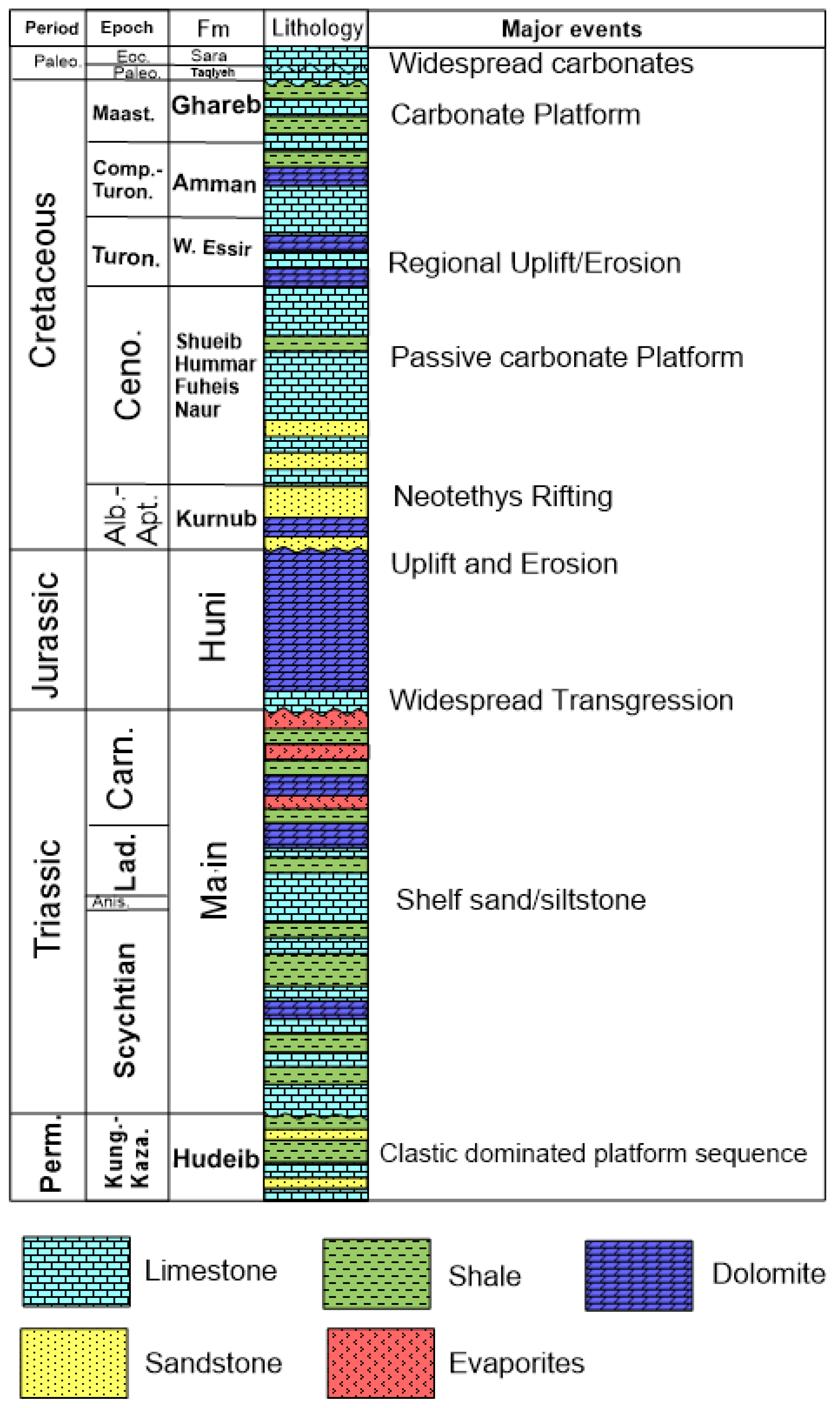


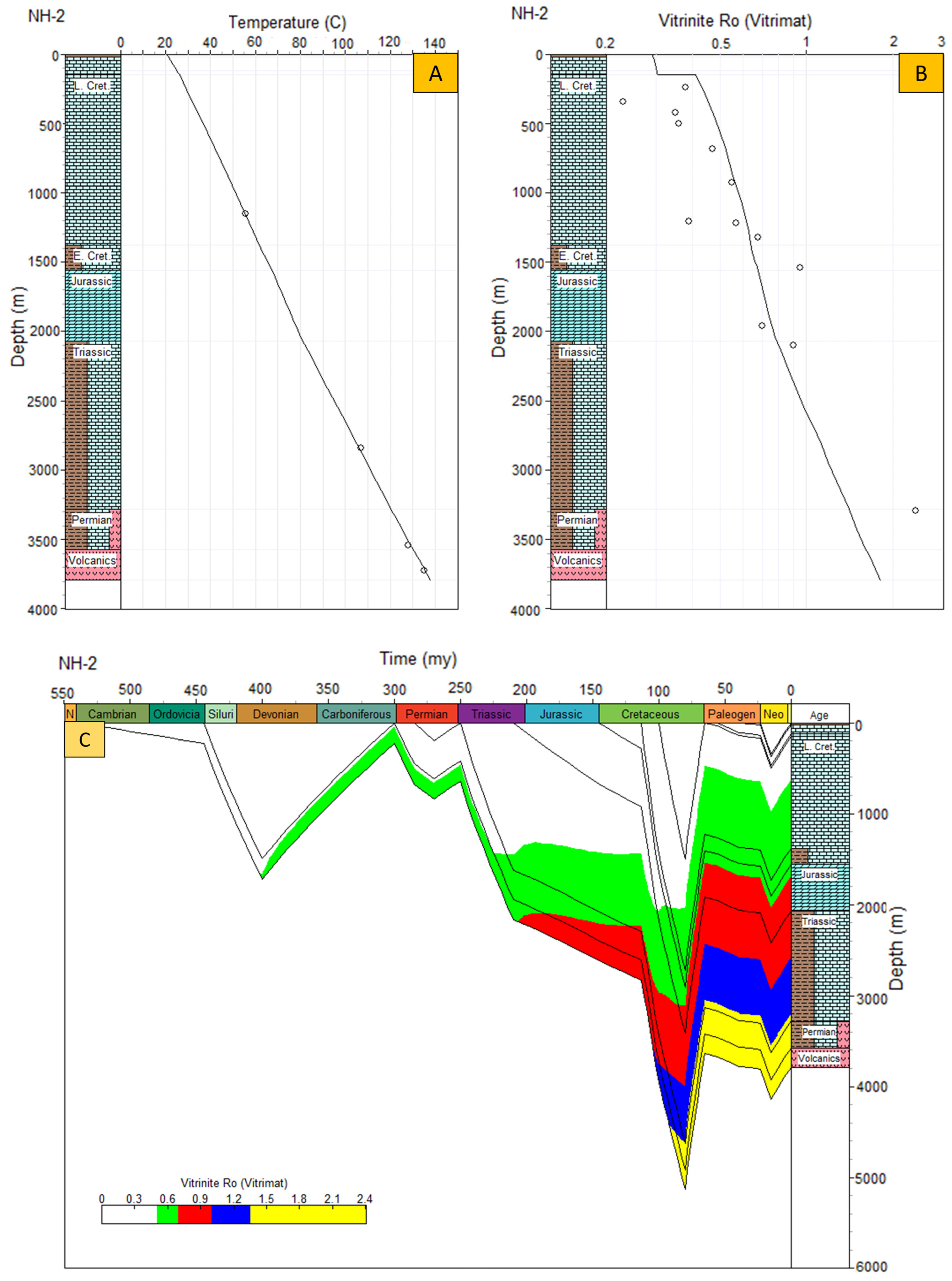

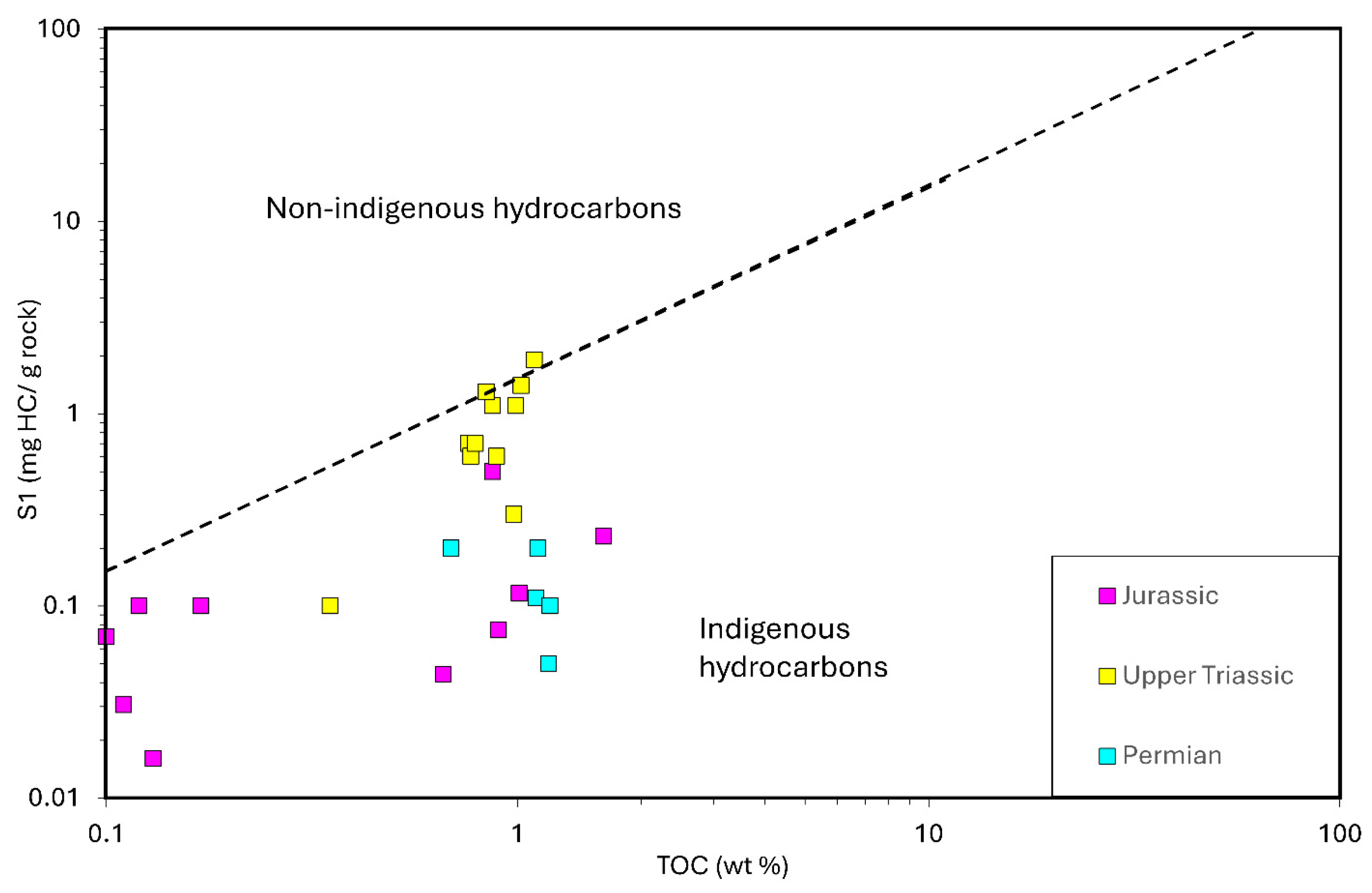

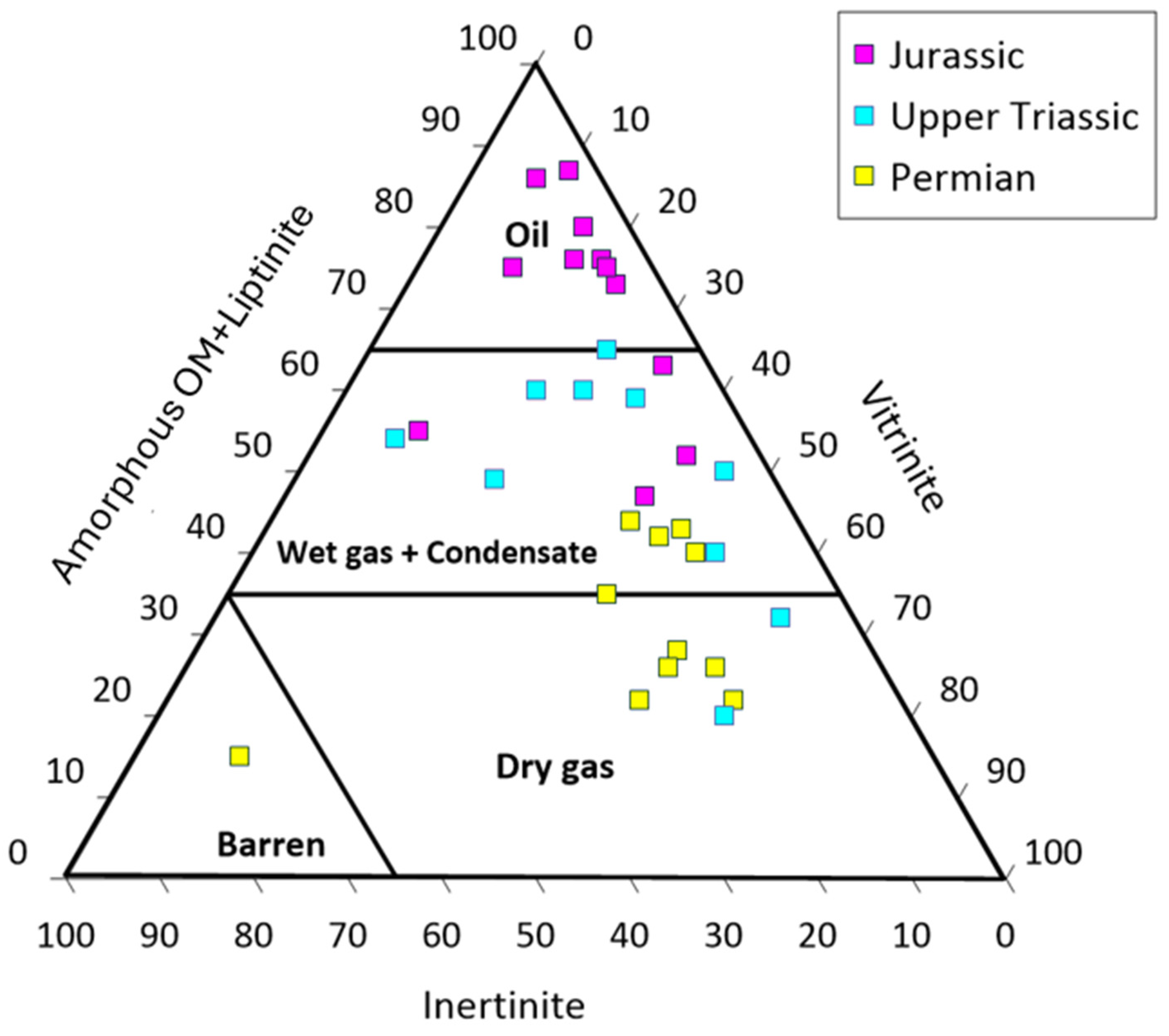
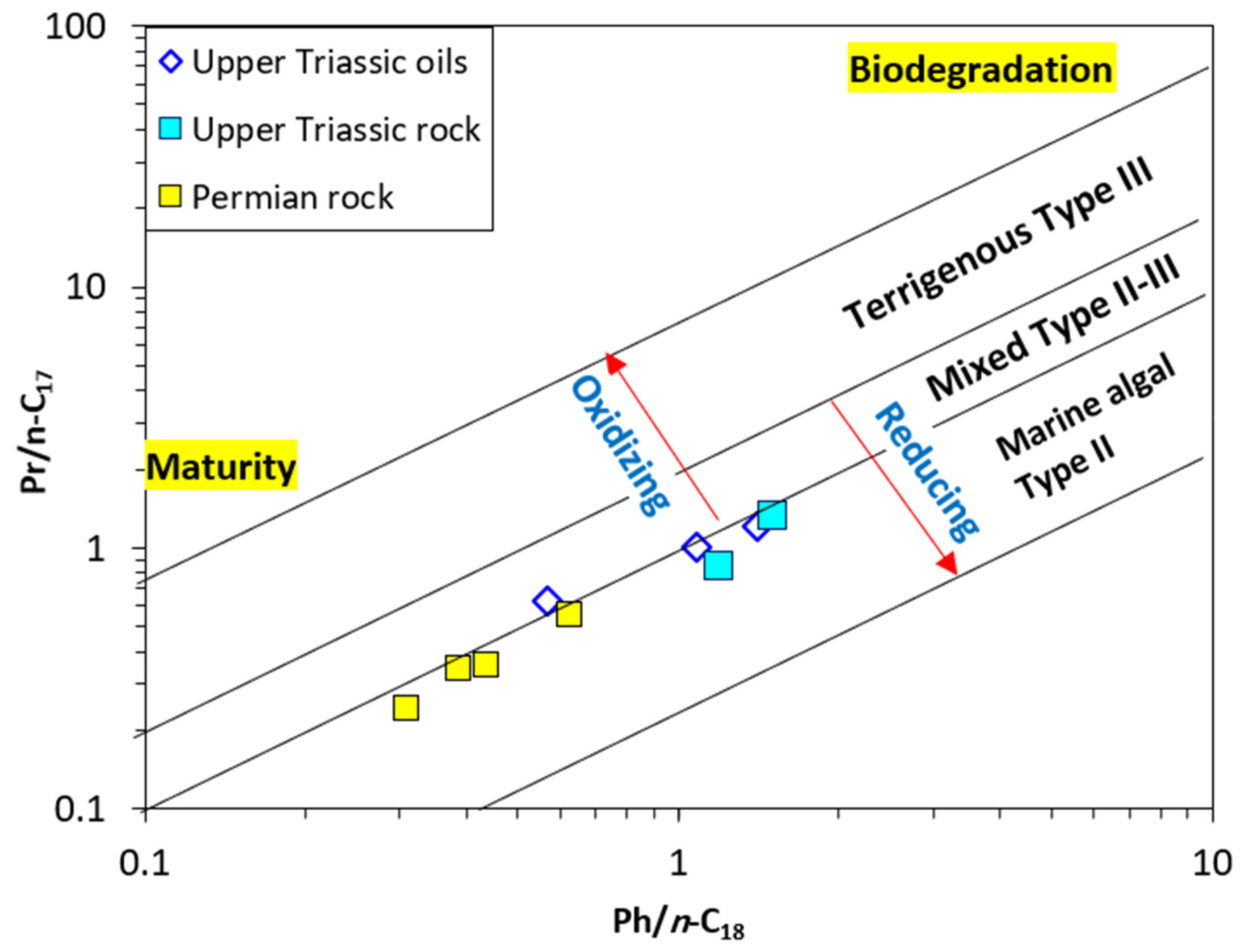
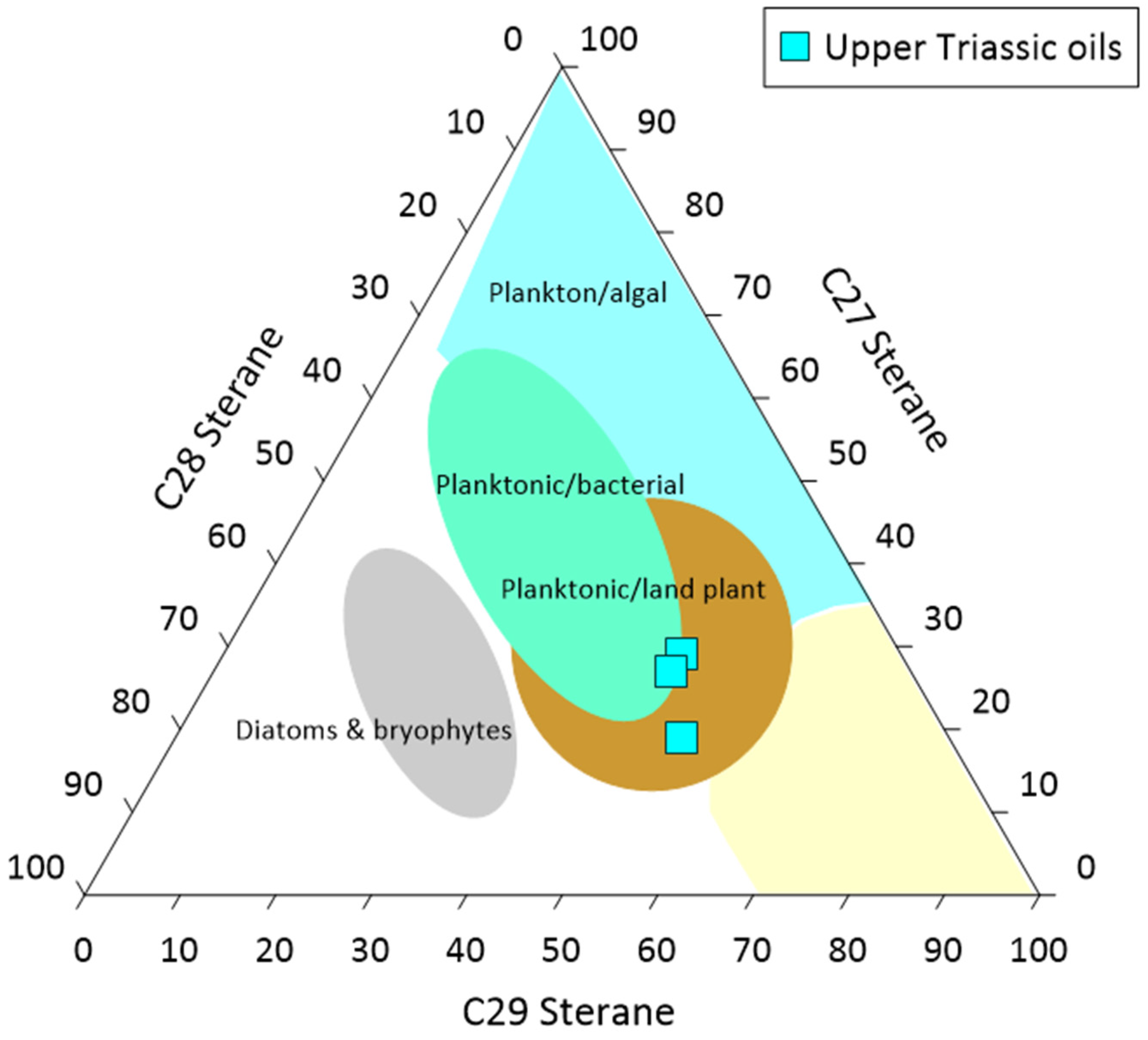
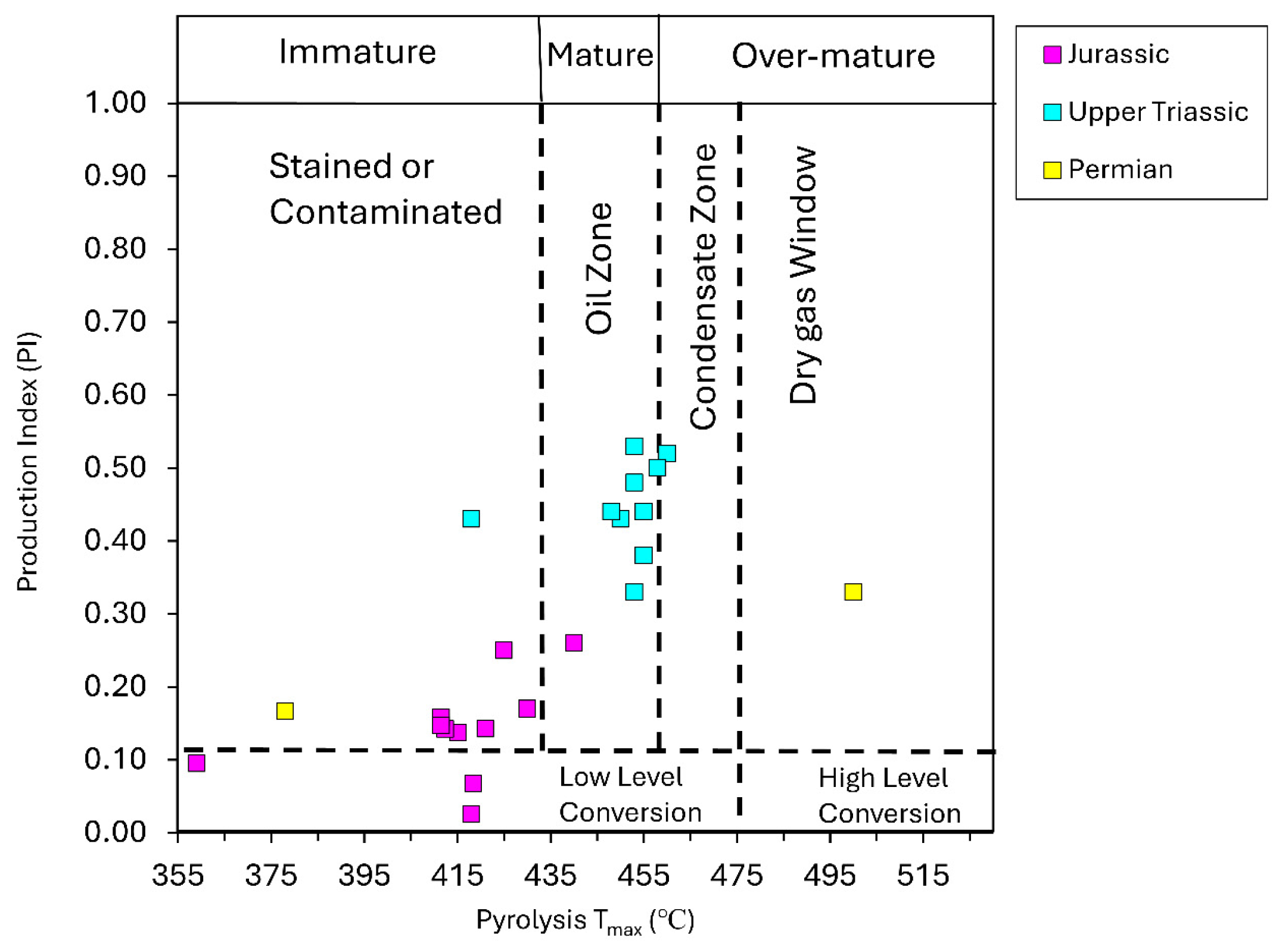
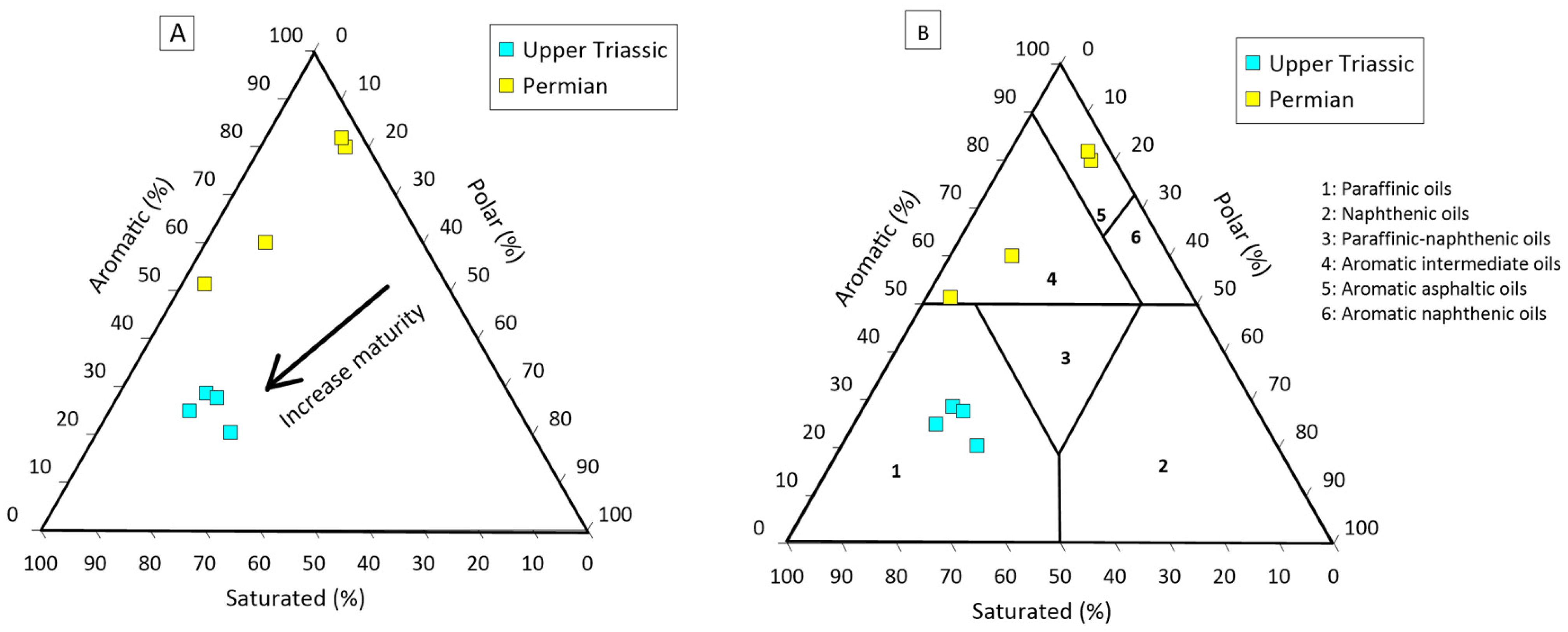
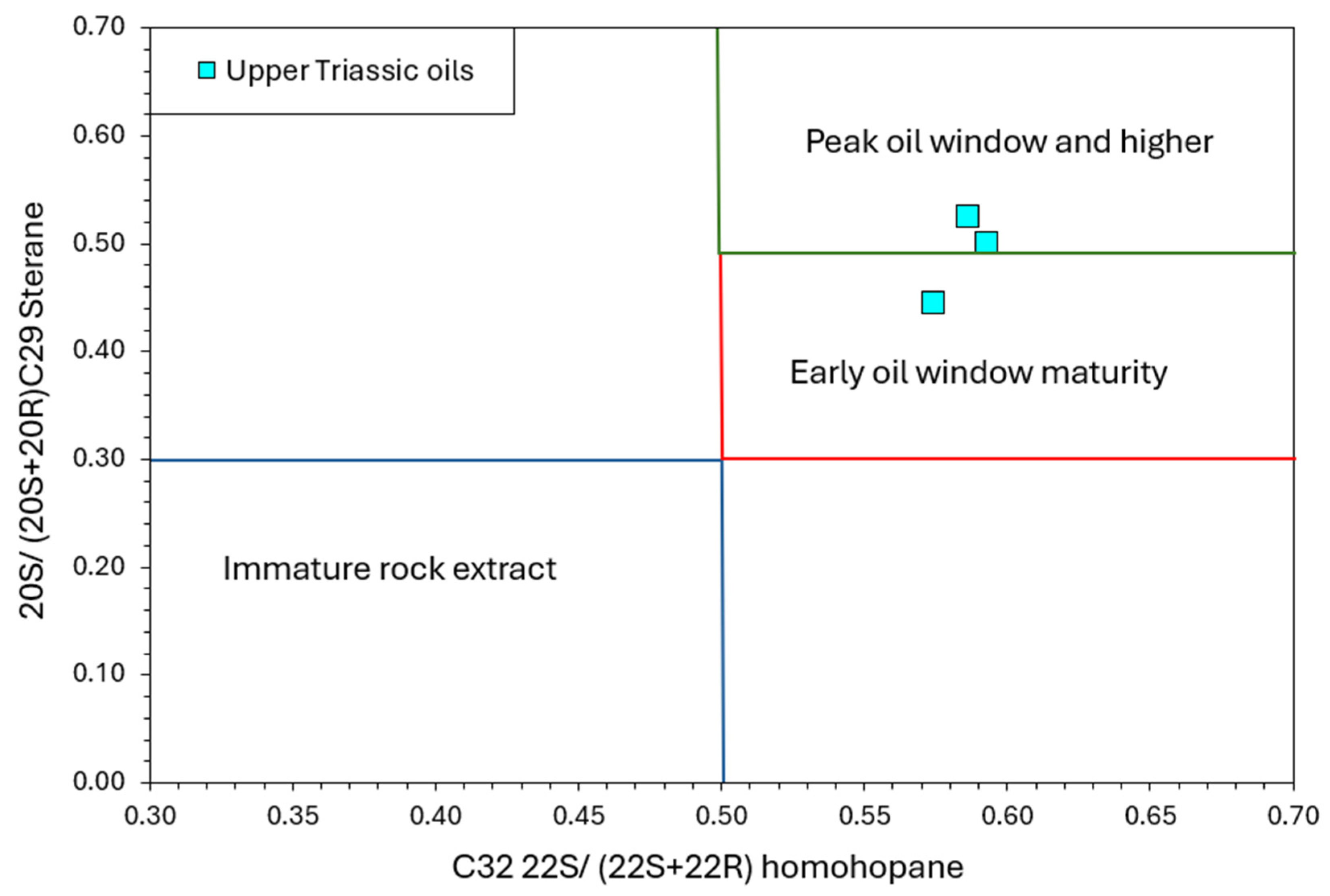

| Well | Age | Sample Type | Lithology | Depth (m) | TOC (wt%) | S1 (mg HC/g Rock) | S2 (mg HC/g Rock) | HI (mg HC/g TOC) | PI | Tmax (°C) |
|---|---|---|---|---|---|---|---|---|---|---|
| AJ-1 | Jurassic | Cuttings | Argillaceous limestone | 1060 | 0.01 | 0.07 | 0.40 | 0.14 | 421 | |
| Cuttings | Argillaceous limestone | 1080 | 0.66 | 0.04 | 0.28 | 0.14 | 415 | |||
| Cuttings | Argillaceous limestone | 1110 | 0.1 | 0.07 | 0.42 | 0.14 | 412 | |||
| Cuttings | Argillaceous limestone | 1160 | 0.11 | 0.03 | 0.16 | 0.16 | 412 | |||
| Cuttings | Argillaceous limestone | 1180 | 0.9 | 0.07 | 0.43 | 0.15 | 412 | |||
| Cuttings | Argillaceous limestone | 1190 | 0.13 | 0.02 | 0.22 | 0.07 | 418 | |||
| Cuttings | Argillaceous limestone | 1200 | 1.01 | 0.12 | 0.59 | 0.17 | 304 * | |||
| Cuttings | Shale | 1220 | 1.62 | 0.23 | 2.19 | 135 | 0.10 | 359 * | ||
| Upper Triassic (Carnian) | Cuttings | Argillaceous limestone | 1546 | 0.28 | ||||||
| Cuttings | Argillaceous limestone | 1550 | 0.33 | |||||||
| Permian (Kazanian– Kungarian) | Cuttings | Shale | 2422 | 1.19 | 0.05 | 0.25 | 21 | 0.17 | ||
| Cuttings | Silty shale | 2470 | 1.11 | 0.11 | 0.55 | 50 | 0.17 | 378 * | ||
| NH-1 | Upper Triassic (Carnian) | Cuttings | Dolomitic limestone | 683 | 0.35 | |||||
| Cuttings | Dolomitic limestone | 660.5 | 0.1 | |||||||
| NH-2 | Jurassic | Cuttings | Dolomite | 1562.5 | 0.27 | |||||
| Cuttings | Dolomite | 1582.5 | 0.87 | 0.5 | 1.7 | 195 | 0.26 | 440 | ||
| Cuttings | Dolomite | 1596.8 | 0.12 | 0.1 | 0.3 | 250 | 0.25 | 425 | ||
| Cuttings | Dolomite | 1606.5 | 0.18 | |||||||
| Cuttings | Dolomite | 1629.5 | 0.17 | 0.1 | 0.5 | 294 | 0.17 | 430 | ||
| Cuttings | Dolomite | 1638.15 | 0.09 | 0.19 | 7.33 | 543 | 0.03 | 418 | ||
| Cuttings | Dolomite | 1682.5 | 0.31 | |||||||
| Cuttings | Dolomite | 1921.5 | 0.1 | |||||||
| Cuttings | Dolomite | 1941.5 | 0.12 | |||||||
| Cuttings | Limestone | 1961.5 | 0.08 | |||||||
| Cuttings | Limestone | 1981.5 | 0.06 | |||||||
| Upper Triassic (Carnian) | Cuttings | Limestone | 2061.5 | 0.19 | ||||||
| Cuttings | Mudstone | 2071 | 0.55 | |||||||
| Cuttings | Calcareous mudstone | 2081.5 | 0.89 | 0.6 | 1.2 | 135 | 0.33 | 453 | ||
| Cuttings | Mudstone | 2101.5 | 0.56 | |||||||
| Cuttings | Silty mudstone | 2121.5 | 0.99 | 1.1 | 1.6 | 162 | 0.43 | 450 | ||
| Cuttings | Silty mudstone | 2141.5 | 0.76 | 0.7 | 0.9 | 455 | 0.44 | 455 | ||
| Cuttings | Silty mudstone | 2161.5 | 0.87 | 1.1 | 1 | 115 | 0.52 | 460 | ||
| Cuttings | Mudstone | 2181.5 | 0.77 | 0.6 | 1 | 130 | 0.38 | 455 | ||
| Cuttings | Mudstone | 2201.5 | 0.84 | 1.3 | 1.3 | 155 | 0.5 | 458 | ||
| Cuttings | Dolomitic mudstone | 2243 | 1.02 | 1.4 | 1.6 | 157 | 0.48 | 453 | ||
| Cuttings | Dolomite | 2261.5 | 0.15 | |||||||
| Cuttings | Argillaceous limestone | 2281.5 | 0.08 | |||||||
| Cuttings | Dolomite | 2294 | 0.08 | |||||||
| Cuttings | Argillaceous limestone | 2301.5 | 0.79 | 0.7 | 0.9 | 114 | 0.44 | 448 | ||
| Core | Limestone | 2313.7 | 0.29 | |||||||
| Cuttings | Dolomitic mudstone | 2321.5 | 0.98 | 0.3 | 0.4 | 41 | 0.43 | 418 | ||
| Cuttings | Mudstone | 2360 | 1.1 | 1.9 | 1.8 | 164 | 0.53 | 453 | ||
| Permian (Kazanian– Kungarian) | Core | Argillaceous limestone | 3291.5 | 0.03 | 0.1 | 0.1 | ||||
| Cuttings | Mudstone | 3300 | 0.05 | |||||||
| Cuttings | Silty mudstone | 3320 | 0.05 | |||||||
| Cuttings | Silty mudstone | 3340 | 1.12 | 0.2 | 0.1 | |||||
| Cuttings | Mudstone | 3358 | 0.69 | 0.2 | ||||||
| Cuttings | Mudstone | 3400 | 1.2 | 0.1 | 0.2 | 17 | 0.33 | 500 | ||
| Cuttings | Silty mudstone | 3640 | 0.12 |
| Well Name | Fm. Name | Depth (m) | AOM (%) | Liptinite (%) | Vitrinite (%) | Inertinite (%) | TAI Scale (1–7) |
|---|---|---|---|---|---|---|---|
| AJ-1 | Jurassic | 994 | 17 | 30 | 38 | 15 | 2− |
| 1060 | 38 | 25 | 32 | 5 | 2− | ||
| 1080 | 45 | 31 | 19 | 5 | 2− | ||
| 1100 | 65 | 21 | 7 | 7 | 2− | ||
| 1141 | 60 | 27 | 10 | 3 | 2− | ||
| 1160 | 50 | 26 | 16 | 8 | 2− | ||
| 1200 | 53 | 20 | 22 | 5 | 2− | ||
| 1220 | 22 | 30 | 40 | 8 | 2− | ||
| 1250 | 50 | 25 | 20 | 5 | 2− | ||
| 1280 | 35 | 45 | 15 | 5 | 2− | ||
| 1300 | 45 | 30 | 10 | 15 | 2− | ||
| 1320 | 35 | 20 | 10 | 35 | 2− | ||
| Upper Triassic | 1340 | 40 | 20 | 25 | 15 | 2− | |
| 1380 | 33 | 16 | 21 | 30 | 2− | ||
| 1400 | 39 | 15 | 8 | 38 | 2 | ||
| 1420 | 40 | 20 | 20 | 20 | 3− | ||
| 1540 | 12 | 47 | 31 | 10 | 3− | ||
| 1560 | 5 | 35 | 49 | 11 | 2+ | ||
| 1590 | 7 | 25 | 60 | 8 | 3− | ||
| 1610 | 27 | 38 | 25 | 10 | 2 | ||
| Permian | 2422.5 | 10 | 18 | 51 | 21 | 2+ | |
| 2430 | 18 | 17 | 40 | 25 | 2+ | ||
| 2440 | 10 | 12 | 50 | 28 | 2+ | ||
| 2450 | 7 | 19 | 51 | 23 | 2+ | ||
| 2470 | 5 | 17 | 60 | 18 | 3 | ||
| 2490 | 5 | 21 | 56 | 18 | 3 | ||
| 2500 | 22 | 22 | 38 | 18 | 3 | ||
| 2530 | 19 | 23 | 42 | 16 | 3 | ||
| 2550 | 13 | 30 | 44 | 13 | 3 | ||
| 2570 | 14 | 26 | 47 | 13 | 3 | ||
| NH-1 | Upper Triassic | 620 | 20 | 60 | 20 | 4 | |
| NH-2 | Jurassic | 1582.5 | 40 | 29 | 31 | 4 | |
| Upper Triassic | 2071 | 1 | 5 | 94 | 4 | ||
| 2121.5 | 5 | 15 | 80 | 4 | |||
| 2243 | 9 | 10 | 81 | 4 to 5 | |||
| 2313.7 | 50 | 45 | 5 | ||||
| Permian | 3340 | 15 | 11 | 74 | 5 to 6 |
| Well Name | Age | Sample Type | Depth (m) | Saturates (%) | Aromatics (%) | Polar Compounds (%) | Pr/Ph | Pr/n-C17 | Ph/n-C18 | CPI | Ph/n-C17 |
|---|---|---|---|---|---|---|---|---|---|---|---|
| NH-2 | Upper Triassic | Oil | 2121.50 | 55.10 | 20.40 | 24.50 | 0.99 | 1 | 1.08 | 1.02 | 1.01 |
| Upper Triassic | Cutting | 2161.50 | 55.40 | 28.60 | 16 | 3 | 1.32 | 1.51 | 1.11 | 0.44 | |
| Upper Triassic | Oil | 2201.50 | 54 | 27.60 | 18.40 | 1 | 1.21 | 1.40 | 1.03 | 1.21 | |
| Upper Triassic | Cutting | 2243 | 60 | 24.90 | 15.10 | 1.2 | 0.63 | 0.57 | 1.02 | 0.53 | |
| Upper Triassic | Oil | 2441.50 | 46.50 | 34.90 | 18.60 | 0.91 | 0.84 | 1.20 | 0.99 | 0.92 | |
| AJ-1 | Permian | Cutting | 2422.5 | 4.43 | 79.88 | 15.69 | 0.8 | 0.34 | 0.39 | 0.65 | 0.43 |
| Permian | Cutting | 2430 | 4.12 | 81.88 | 14 | 0.58 | 0.24 | 0.31 | 1.18 | 0.41 | |
| Permian | Cutting | 2440 | 44.39 | 51.40 | 4.21 | 0.68 | 0.35 | 0.44 | 1.56 | 0.51 | |
| Permian | Cutting | 2450 | 28.94 | 59.96 | 11.10 | 0.61 | 0.55 | 0.63 | 1.45 | 0.90 |
| Well Name | Fm. Age | Sample Type | Depth (m) | αββ Sterane | C29 20S/(20S + 20R) Sterane | C32 22S/(22S + 22R) Homohopane | Triterpane Ratios | MPI-1 | Rc% | Triaromatic Steranes | |||
|---|---|---|---|---|---|---|---|---|---|---|---|---|---|
| %C27 | %C28 | %C29 | Ts/Tm | Norhopane/Hopane | C28/(C26 + C27) | ||||||||
| NH-2 | Upper Triassic | Oil | 2121.5 | 29 | 23 | 48 | 0.50 | 0.59 | 3.60 | 0.43 | 0.42 | 0.65 | 1.50 |
| Upper Triassic | Oil | 2201.5 | 19 | 28 | 53 | 0.44 | 0.57 | 4.50 | 0.32 | 0.47 | 0.68 | 1.80 | |
| Upper Triassic | Oil | 2423 | 27 | 25 | 48 | 0.52 | 0.59 | 2.40 | 0.52 | 0.37 | 0.62 | 1.40 | |
| Peak Identifications for Triterpanes (m/z 191) | |
|---|---|
| Ts | 18α(H), 21β(H)-22,29,30-trisnorhopane |
| Tm | 17α(H), 21β(H)-22,29,30-trisnorhopane |
| NH | 17α(H), 21β(H)-30-norhopane |
| H | 17α, 21β-hopane |
| Me | 17α(H), 21β(H)-homohopane (22S and 22R) |
| G | Gammacerane |
| Et | 17α(H), 21β(H)-bishomohopane (22S and 22R) |
| Pr | 17α(H), 21β(H)-trishomohopane (22S and 22R) |
| Bu | 17α(H), 21β(H)-tetrakishhomohopane (22S and 22R) |
| Peak Identifications for Steranes (m/z 217) | |
| A | 13β, 17α-diacholestane (20S) |
| B | 13β, 17α-diacholestane (20R) |
| C | 13β, 17α-24-methyl diacholestane (20S) |
| D | 13β, 17α-24-methyl diacholestane (20R) |
| E | 13β, 17α-24-ethyl diacholestane (20R) |
| F | 5α, 14α, 17α cholestane (20S) |
| G | 5α, 14α, 17α cholestane (20R) |
| H | 5α, 14α, 17α methyl cholestane (20S) |
| I | 5α, 14α, 17α-24- methyl cholestane (20R) |
| J | 5α, 14α, 17α -24-ethyl cholestane (20S) |
| K | 5α, 14α, 17α -24-ethyl cholestane (20R) |
| Peak Identifications for Steranes (m/z 218) | |
| A | 5α, 14β, 17β cholestane (20R) |
| B | 5α, 14β, 17β cholestane (20S) |
| C | 5α, 14β, 17β-24-methyl cholestane (20R) |
| D | 5α, 14β, 17β-24-methyl cholestane (20S) |
| E | 5α, 14β, 17β -24-ethyl cholestane (20R) |
| F | 5α, 14β, 17β -24-ethyl cholestane (20S) |
| Well | Depth (m) | Sample Type | Ro% | Number of Readings | Standard Deviation | Depth (m) | BHT (°C) |
|---|---|---|---|---|---|---|---|
| NH-1 | 108 | Cuttings | 0.32 | 5 | 0.11 | 800 | 45 |
| 123.5 | Cuttings | 0.3 | 6 | 0.09 | 1242 | 58 | |
| 167.5 | Cuttings | 0.46 | 2 | 0.07 | 2424 | 90 | |
| 233 | Cuttings | 0.67 | 8 | 0.06 | |||
| 380 | Cuttings | 0.41 | 4 | 0.16 | |||
| 425.5 | Cuttings | 0.4 | 25 | 0.05 | |||
| 482.5 | Cuttings | 0.41 | 24 | 0.05 | |||
| 505.5 | Cuttings | 0.44 | 21 | 0.07 | |||
| 555.5 | Cuttings | 0.49 | 27 | 0.09 | |||
| 583 | Cuttings | 0.59 | 4 | 0.16 | |||
| 603 | Cuttings | 0.68 | 3 | 0.23 | |||
| NH-2 | 241.5 | Cuttings | 0.38 | 3 | 0.03 | 1150 | 57 |
| 341.5 | Cuttings | 0.23 | 1 | 0.00 | 2800 | 107 | |
| 421.5 | Cuttings | 0.35 | 7 | 0.07 | 3500 | 129 | |
| 500.5 | Cuttings | 0.36 | 3 | 0.02 | 3750 | 135 | |
| 683 | Cuttings | 0.47 | 4 | 0.08 | |||
| 924.5 | Core | 0.55 | 2 | 0.04 | |||
| 1206.35 | Core | 0.39 | 2 | 0.00 | |||
| 1221.5 | Cuttings | 0.57 | 3 | 0.02 | |||
| 1322.5 | Cuttings | 0.68 | 9 | 0.08 | |||
| 1542.5 | Cuttings | 0.95 | 20 | 0.00 | |||
| 1961.5 | Cuttings | 0.7 | 1 | 0.22 | |||
| 2101.5 | Cuttings | 0.90 | 9 | 0.30 |
| NH-1 Well | |||||||||
| Fm. | Top (m) | Bottom (m) | Thickness (m) | Lithology | Age | Erosion | Eroded Thickness (m) | ||
| From | To | From | To | ||||||
| Oligocene | 0 | 10 | 10 | sh100 | 39 | 23 | 15 | 0 | 350 |
| Eocene | 10 | 11 | 1 | ls100 | 56 | 39 | |||
| Paleocene | 11 | 60 | 49 | ls100 | 65 | 56 | 80 | 65 | 2000 |
| Late Cretaceous | 60 | 347 | 287 | ls100 | 113 | 100 | |||
| Early Cretaceous | 347 | 523 | 176 | ss71, sh24, co5 | 145 | 113 | |||
| Jurassic | 523 | 620 | 97 | ss100 | 210 | 145 | |||
| Triassic | 620 | 1126 | 506 | sh40, do60 | 250 | 210 | 284 | 250 | 500 |
| Permian | 1126 | 1127 | 1 | sh40, ls40, ig20 | 300 | 298 | 400 | 300 | 500 |
| Cambro-Ordovician | 1127 | 4050 | 2923 | ss71, sh24, ls5 | 540 | 444 | |||
| NH-2 well | |||||||||
| Fm. | Top (m) | Bottom (m) | Thickness (m) | Lithology | Age | Erosion | Eroded Thickness (m) | ||
| From | To | From | To | ||||||
| Oligocene | 0 | 20 | 20 | sh100 | 39 | 23 | 15 | 0 | 350 |
| Eocene | 20 | 120 | 100 | ls100 | 56 | 39 | |||
| Paleocene | 120 | 150 | 30 | ls100 | 65 | 56 | 80 | 65 | 1500 |
| Late Cretaceous | 150 | 1380 | 1230 | ls100 | 113 | 100 | |||
| Early Cretaceous | 1380 | 1560 | 180 | sh30, ls70 | 145 | 113 | |||
| Jurassic | 1560 | 2071 | 511 | do100 | 210 | 145 | |||
| Triassic | 2071 | 3283 | 1212 | sh40, ls60 | 250 | 210 | 270 | 250 | 200 |
| Permian | 3283 | 3575 | 292 | sh40, ls40, ig20 | 300 | 285 | 400 | 300 | 1500 |
| Volcanics | 3575 | 3790 | 215 | ig100 | 540 | ||||
Disclaimer/Publisher’s Note: The statements, opinions and data contained in all publications are solely those of the individual author(s) and contributor(s) and not of MDPI and/or the editor(s). MDPI and/or the editor(s) disclaim responsibility for any injury to people or property resulting from any ideas, methods, instructions or products referred to in the content. |
© 2024 by the authors. Licensee MDPI, Basel, Switzerland. This article is an open access article distributed under the terms and conditions of the Creative Commons Attribution (CC BY) license (https://creativecommons.org/licenses/by/4.0/).
Share and Cite
Hamdy, D.; Farouk, S.; Qteishat, A.; Ahmad, F.; Al-Kahtany, K.; Gentzis, T.; Jovane, L.; Zaky, A.S. Source Rock Assessment of the Permian to Jurassic Strata in the Northern Highlands, Northwestern Jordan: Insights from Organic Geochemistry and 1D Basin Modeling. Minerals 2024, 14, 863. https://doi.org/10.3390/min14090863
Hamdy D, Farouk S, Qteishat A, Ahmad F, Al-Kahtany K, Gentzis T, Jovane L, Zaky AS. Source Rock Assessment of the Permian to Jurassic Strata in the Northern Highlands, Northwestern Jordan: Insights from Organic Geochemistry and 1D Basin Modeling. Minerals. 2024; 14(9):863. https://doi.org/10.3390/min14090863
Chicago/Turabian StyleHamdy, Dina, Sherif Farouk, Abdelrahman Qteishat, Fayez Ahmad, Khaled Al-Kahtany, Thomas Gentzis, Luigi Jovane, and Amr S. Zaky. 2024. "Source Rock Assessment of the Permian to Jurassic Strata in the Northern Highlands, Northwestern Jordan: Insights from Organic Geochemistry and 1D Basin Modeling" Minerals 14, no. 9: 863. https://doi.org/10.3390/min14090863







